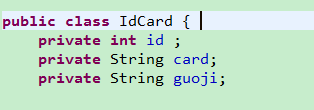引入架包
配置文件
数据库配置文件
配置MyBatisConfig文件
<?xml version="1.0" encoding="UTF-8" ?>
<!DOCTYPE configuration
PUBLIC "-//mybatis.org//DTD Config 3.0//EN"
"http://mybatis.org/dtd/mybatis-3-config.dtd">
<configuration>
<!-- 引入连接数据库文件 -->
<properties resource="db.properties"></properties>
<!-- 配置别名(即在mapper配置文件用到类时的名字),这里设置类的别名即为类的名称 -->
<typeAliases>
<package name="com.mingde.po"/>
</typeAliases>
<!-- 配置开发环境 -->
<environments default="development">
<environment id="development">
<!-- 配置事务 -->
<transactionManager type="JDBC" />
<dataSource type="POOLED">
<property name="driver" value="${driver}"/>
<property name="url" value="${url}"/>
<property name="username" value="${username}"/>
<property name="password" value="${password}"/>
</dataSource>
</environment>
</environments>
<!-- 引入映射SQL语句文件 -->
<mappers>
<!-- 引入指定的SQL语句mapper映射文件 -->
<mapper resource="com\mingde\mapper\mapper.xml" />
<!-- 引入整个包所有的SQL语句mapper映射文件 -->
<!-- <package name="com.mingde.mapper"/> -->
</mappers>
</configuration>
配置MybatisUtils (SqlSessionFactory工厂)
package com.mingde.utils;
import java.io.InputStream;
import org.apache.ibatis.io.Resources;
import org.apache.ibatis.session.SqlSession;
import org.apache.ibatis.session.SqlSessionFactory;
import org.apache.ibatis.session.SqlSessionFactoryBuilder;
public class MyBatisUtils {
//加载引入资源文件,创建工厂(该工厂内部会解析MyBatis配置文件,根据数据库配置,别名配置和mapper的sql映射文件,去找到该映射文件去执行SQL语句)
private static SqlSessionFactory getSqlSessionFactory()throws Exception{
//利用流的方式将MyBatis配置文件引入,然后根据配置文件的内容创建工厂
InputStream inputStram = Resources.getResourceAsStream("myBatisConfig.xml");
//将MyBatis配置文件已流方式引,创建SqlSession工厂
return new SqlSessionFactoryBuilder().build(inputStram);
}
//打开该工厂,进行运行操作;(后面加上参数:‘true’,表示当执行增删改时自动commit提交,这样就不用每次都手动session.commit()去提交)
//若后面的参数不写,则默认为false,得每次自己手动去session.commit()提交;
public static SqlSession getSqlSession()throws Exception{
return getSqlSessionFactory().openSession(true);
}
}
Mapper配置文件(见下方各个方法的不同配置)
方法一:继承关系
实体类


Mapper.xml配置
<?xml version="1.0" encoding="UTF-8" ?>
<!DOCTYPE mapper
PUBLIC "-//mybatis.org//DTD Mapper 3.0//EN"
"http://mybatis.org/dtd/mybatis-3-mapper.dtd">
<mapper namespace="test">
<!-- 查询所有的员工并同时将其关联的身份ID查询出来 -->
<!-- 方法一:【一对一关联】 使用自定义类Employee -->
<select id="seeAll" resultType="Employee">
select * from employee e,idcard i where e.eid=i.id
</select>
</mapper>
测试类
public static void main(String[] args) throws Exception {
//引用已打开准备好的工厂
SqlSession session = MyBatisUtils.getSqlSession();
//调用mapper.xml的方法,调用的方式为:mapper.xml文件里的‘namespace的值+id的值’,如:test.seeAll
List<Object> selectList = session.selectList("test.seeAll");
System.out.println(selectList);
//关闭session
session.close();
}
运行结果
方法二:一对一关联关系
实体类:
public class Employee {
private int eid;
private String ename;
private String sex;
private int age;
private String birth;
public class IdCard {
private int id ;
private String card;
private String guoji;
private Employee emp; //一对一关系
Mapper.xml配置
<!-- 方法二: -->
<!-- 定义ResultMap -->
<resultMap type="IdCard" id="IdCards">
<id column="id" property="id" />
<result column="card" property="card" />
<result column="guoji" property="guoji" />
<!-- 映射关联属性 emp-->
<association property="emp" javaType="Employee">
<id column="eid" property="eid" />
<result column="ename" property="ename" />
<result column="sex" property="sex" />
<result column="age" property="age" />
<result column="birth" property="birth" />
</association>
</resultMap>
<!-- 查询所有 -->
<select id="seeAll2" resultMap="IdCards">
select * from idCard c ,Employee e where e.eid=c.id
</select>
<!-- 根据id查询 -->
<select id="findOne2" resultMap="IdCards">
select * from idCard c ,Employee e where e.eid=c.id and id=#{value}
</select>
测试类
@Test
public void test2() throws Exception {
SqlSession session = MyBatisUtils.getSqlSession();
List<Object> list = session.selectList("test.seeAll2");
System.out.println(list);
Object object = session.selectOne("test.findOne2", 1001);
System.out.println(object);
}
运行结构:
方法三:一对一关联关系:延迟加载(建议用该方法,较实用)
实体类与方法二的一致(一对一关联关系,一个类中的属性定义另一个类)
Mapper.xml配置
<!-- 方法三:延迟加载 -->
<resultMap type="IdCard" id="IdCards3">
<id column="id" property="id"/>
<!-- 映射关联属性 emp -->
<!-- 下面的映射的条件是进入select方法进行该定义的方法查,然后返回对象,查询的参数为column的内容,一旦用该方法的话,默认的是懒加载 fetchType="lazy",该条件可写可不写 -->
<!-- 实现对用户信息进行延迟加载 select:指定延迟加载需要执行的方法 ,column为列的外建-->
<association property="emp" javaType="Employee" column="id" select="findID" />
</resultMap>
<!-- 上面懒加载的方法 -->
<select id="findID" resultType="Employee" parameterType="int" >
select * from Employee where eid=#{value}
</select>
<!-- 查询所有 -->
<select id="seeAll3" resultMap="IdCards3">
select * from idCard
</select>
<!-- 根据id查询 -->
<select id="findOne3" resultMap="IdCards3" parameterType="int">
select * from idCard c where id=#{value}
</select>
测试类
//方法三测试
@Test
public void test3() throws Exception {
SqlSession session = MyBatisUtils.getSqlSession();
List<Object> list = session.selectList("test.seeAll3");
System.out.println(list);
Object object = session.selectOne("test.findOne3", 1001);
System.out.println(object);
}
运行结果:

方法四:注解(注解不用定义Mapper.xml配置文件)
定义接口
package com.mingde.dao;
import java.util.List;
import org.apache.ibatis.annotations.One;
import org.apache.ibatis.annotations.Result;
import org.apache.ibatis.annotations.ResultMap;
import org.apache.ibatis.annotations.Results;
import org.apache.ibatis.annotations.Select;
import org.apache.ibatis.mapping.FetchType;
import com.mingde.po.IdCard;
public interface IdCardDao {
//查询所有
@Select("select * from idCard ")
//在注解中定义ResultMap
@Results(id="IdCards",value={
@Result(column="id",property="id"),
@Result(column="card",property="card"),
@Result(column="guoji",property="guoji"),
@Result(property="emp",column="id",one=@One(select="com.mingde.dao.EmpDao.findEmp",fetchType=FetchType.LAZY))
//上面的select写对应的类的方法
})
public List<IdCard> SeeAll() throws Exception;
//根据id查询单个对象
@Select("select * from idCard whereid=#{value} ")
@ResultMap("IdCards") //使用上面定义好的ResultMap方法
public IdCard findIdCardById(int id)throws Exception;
}
package com.mingde.dao;
import org.apache.ibatis.annotations.Select;
import com.mingde.po.Employee;
public interface EmpDao {
@Select("select * from Employee where eid=#{value}")
public Employee findEmp(int eid)throws Exception;
}
测试类
//方法四测试
@Test
public void test4() throws Exception {
SqlSession session = MyBatisUtils.getSqlSession();
IdCardDao mapper = session.getMapper(IdCardDao.class);
List seeAll = mapper.SeeAll();
System.out.println(seeAll);
IdCard obj = mapper.findIdCardById(1001);
System.out.println(obj);
}
运行结果































 340
340











 被折叠的 条评论
为什么被折叠?
被折叠的 条评论
为什么被折叠?








